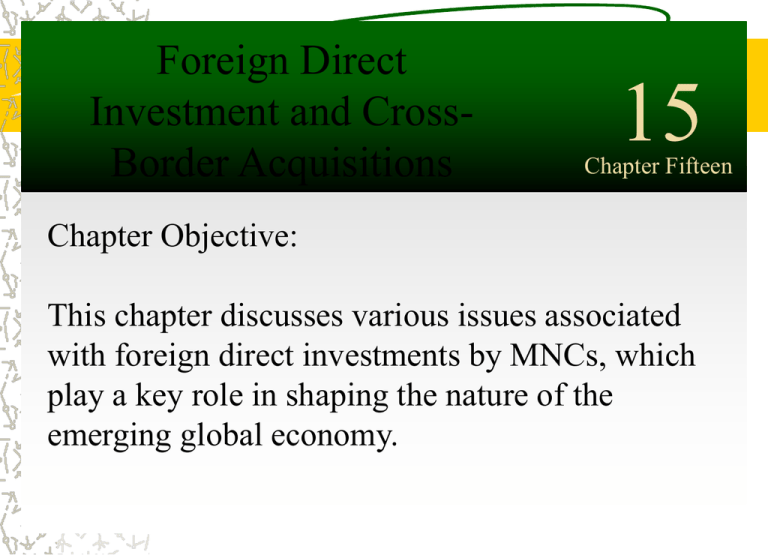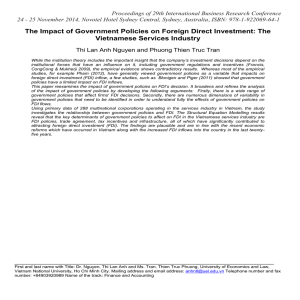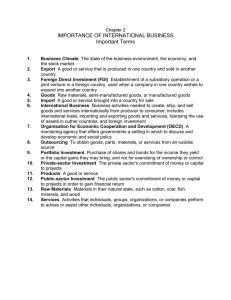15 Foreign Direct Investment and Cross- Border Acquisitions
advertisement

Foreign Direct Investment and CrossBorder Acquisitions Chapter Objective: 15 Chapter Fifteen INTERNATIONAL FINANCIAL MANAGEMENT This chapter discusses various issues associated with foreign direct investments by MNCs, which Third Edition play a key role in shaping the nature of the EUN / RESNICK emerging global economy. Chapter 15 Foreign Direct Investment and Cross Border Acquisitions Chapter Outline Global Trends in FDI Why Do Firms Invest Overseas? Cross-Border Mergers and Acquisitions Political Risk and FDI Global Trends in FDI Foreign Direct Investment often involves the establishment of production facilities abroad. Greenfield Investment – Involves building new facilities from the ground up. Cross-Border Acquisition – Involves the purchase of existing business. Global Trends in FDI Several developed nations are the sources of FDI outflows. – About 90% of total world-wide FDI comes from the developed world. Both developing and developed nations are the recipient of inflows of FDI. 1.7 15 Mexico 21 25.5 25.3 9.3 Sweden Switzerland Outflow s 139.2 134.5 202.3 250 United States 71.7 Inflow s United Kingdom 31.1 18.6 Spain 46.6 37.1 28.5 6.7 Japan 0 12.6 8.3 150 Netherlands 91 65.8 62.2 38.8 43.5 200 Italy Germany France 1.7 29.4 29.3 100 China Canada 5.5 7.4 50 Australia Average Annual FDI (in Billions) 1997-2001 Why Do Firms Invest Overseas? Trade Barriers Labour Market Imperfections Intangible Assets Vertical Integration Product Life Cycle Shareholder Diversification Trade Barriers Government action leads to market imperfections. Tariffs, quotas, and other restrictions on the free flow of goods, services and people. Trade Barriers can also arise naturally due to high transportation costs, particularly for low value-toweight goods. Labour Market Imperfections Among all factor markets, the labor market is the least perfect. – Recall that the factors of production are land, labor, capital, and entrepreneurial ability. If there exist restrictions on the flow of workers across borders, then labor services can be underpriced relative to productivity. – The restrictions may be immigration barriers or simply social preferences. Labour Market Costs Around the World (2001) Persistent wage differentials across countries exist. This is one on the main reasons MNCs are making substantial FDIs in less developed nations. Country Germany U.S. Japan Israel Taiwan Mexico Hourly Cost $23.04 $20.67 $19.52 $10.54 $5.44 $1.70 Intangible Assets Coca-Cola has a very valuable asset in its closely guarded “secret formula”. To protect that proprietary information, Coca-Cola has chosen FDI over licensing. Since intangible assets are difficult to package and sell to foreigners, MNCs often enjoy a comparative advantage with FDI. Vertical Integration MNCs may undertake FDI in countries where inputs are available in order to secure the supply of inputs at a stable accounting price. Vertical integration may be backward or forward: – Backward: e.g. a furniture maker buying a logging company. – Forward: e.g. a U.S. auto maker buying a Japanese auto dealership. Product Life Cycle U.S. firms develop new products in the developed world for the domestic market, and then markets expand overseas. FDI takes place when product maturity hits and cost becomes an increasingly important consideration for the MNC. Product Life Cycle Quantity The U.S. New product Quantity Less advanced countries exports imports Maturing product Standardized product exports imports New product Maturing product Standardized product Product Life Cycle It should be noted that the Product Life Cycle theory was developed in the 1960s when the U.S. was the unquestioned leader in R&D and product innovation. Increasingly product innovations are taking place outside the United States as well, and new products are being introduced simultaneously in many advanced countries. Production facilities may be located in multiple countries from product inception. Shareholder Diversification Firms may be able to provide indirect diversification to their shareholders if there exists significant barriers to the cross-border flow of capital. Capital Market imperfections are of decreasing importance, however. Managers can therefore probably not add value by diversifying for their shareholders as the shareholders can do so themselves at lower cost. Cross-Border Mergers & Acquisitions Greenfield Investment – Building new facilities from the ground up. Cross-Border Acquisition – Purchase of existing business. – Cross-Border Acquisition represents 40-50% of FDI flows. Cross-border acquisitions are a politically sensitive issue: – Greenfield investment is usually welcome. – Cross-border acquisition is often unwelcome. Top 10 Cross-Border M&A Deals 1996-2001 Year ($ b) Acquirer Home Target Host 2000 202.8 Vodafone Airtouch PLC U.K. Mannesmann AG Germany 1999 60.3 Vodafone Group PLC U.K. Airtouch U.S. 1998 48.2 British Petroleum Co. U.K. Amoco U.S. 2000 46 France Telecom SA France Orange PLC U.K. 1998 40.5 Daimer-Benz AG Germany Chrysler Corp. U.S. 2000 40.4 Vivendi SA France Seagram Co. LTD Canada 1999 34.6 Zeneca Group PLC U.K. Astra AB Sweden 1999 32.6 Mannesmann AG Germany Orange PLC U.K. 2001 29.4 VoiceStream Wireless Corp U.S. Deutsche Telekom AG Germany 2000 27.2 BP Amoco PLC U.K. ARCO U.S. Average Wealth Gains from Cross-Border Acquisitions: Foreign Acquisitions of U.S. firms. Country of Acquirer N R&D/Sales (%) Acquirer Target Average Wealth Gain (U.S. $millions) Acquirer Target Canada 10 0.21 0.65 14.93 85.59 Japan 15 5.08 4.81 227.83 170.66 U.K. 46 1.11 2.18 –122.91 94.55 Other 32 1.63 2.80 –47.56 89.48 103 1.66 2.54 –35.01 103.19 All Political Risk and FDI Unquestionably this is the biggest risk when investing abroad. “Does the foreign government uphold the rule of law?” is a more important question than normative judgements about the appropriateness of the foreign government’s existing legislation. A big source of risk is the non-enforcement of contracts. Political Risk and FDI Macro Risk – All foreign operations put at risk due to adverse political developments. Micro Risk – Selected foreign operations put at risk due to adverse political developments. Political Risk Transfer Risk – Uncertainty regarding cross-border flows of capital. Operational Risk – Uncertainty regarding host countries policies on firm’s operations. Control Risk – Uncertainty regarding expropriation. Measuring Political Risk The host country’s political and government system. – A country with too many political parties and frequent changes of government is risky. Track records of political parties their relative strength. – If the socialist party is likely to win the next election, watch out. Measuring Political Risk Integration into the world system. – North Korea, Iraq, Libya are examples of isolationist countries unlikely to observe the rules of the game. Ethnic and religious stability. – Look at the recent civil war in Bosnia. Regional security – Kuwait is a nice enough country, but it’s in a rough neighborhood. Measuring Political Risk Key economic indicators – Political risk is not entirely independent of economic risk. – Severe income inequality and deteriorating living standards can cause major political disruptions. – In 2002, Argentina’s protracted economic recession led to the freezing of bank deposits, street riots, and three changes of the country’s presidency in as many months. Hedging Political Risk Geographic diversification – Simply put, don’t put all of your eggs in one basket. Minimize exposure – Form joint ventures with local companies. • Local government may be less inclined to expropriate assets from their own citizens. – Join a consortium of international companies to undertake FDI. • Local government may be less inclined to expropriate assets from a variety of countries all at once. – Finance projects with local borrowing. Hedging Political Risk Insurance – The Overseas Private Investment Corporation (OPIC) a U.S. government federally owned organization, offers insurance against: 1. The inconvertibility of foreign currencies. 2. Expropriation of U.S.-owned assets. 3. Destruction of U.S.-owned physical properties due to war, revolution, and other violent political events in foreign countries. 4. Loss of business income due to political violence





